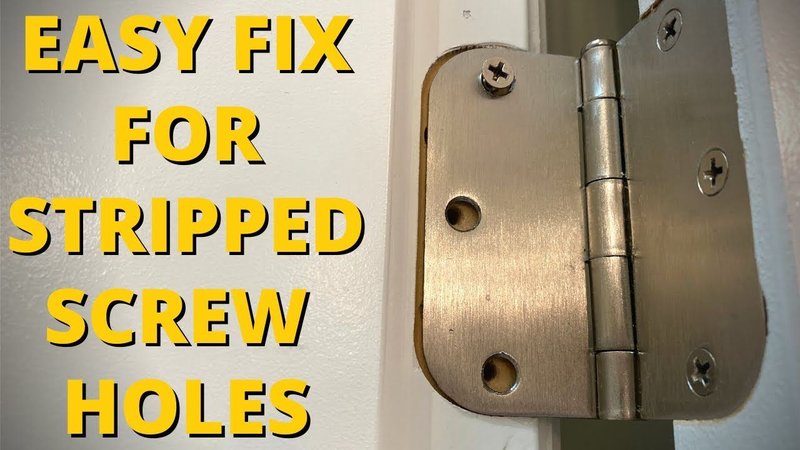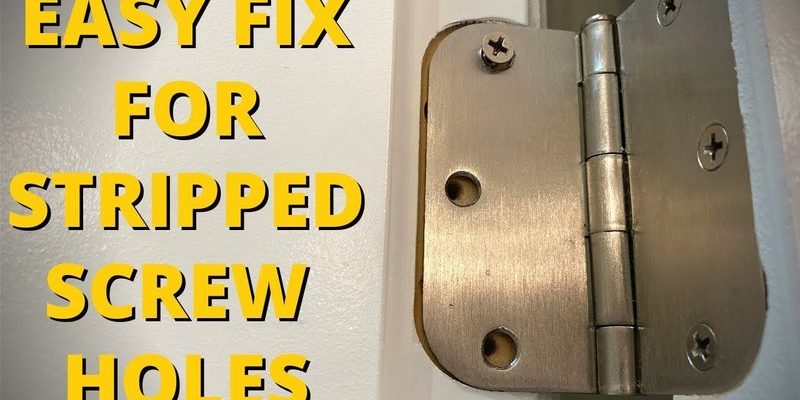
Honestly, a floppy exterior door hinge isn’t just an eyesore or a noise problem. It’s a real security risk and an energy drain—letting in drafts, bugs, or worse. Maybe you’re not sure what “slop” actually means in this context, or you’re worried fixing door hardware sounds like a pro-only job. Trust me: with a little patience and a few tools, it’s totally doable for a DIYer. Let’s break down how to spot hinge slop, what causes it, and your best options for fixing an exterior door hinge that’s seen better days.
What Is Hinge Slop and Why Does It Happen?
You might be wondering, “How do I know if my exterior door hinge is just loose or if it genuinely has excessive slop?” *Slop* in the world of door hardware means there’s too much play or movement in the hinge joint itself. Imagine opening your door and feeling it move side to side, or hearing a persistent creak or clunk. That’s slop.
Here’s the thing: Over time, as people push or pull on a heavy exterior door—especially steel or solid wood models—the screws or hinge pins can slowly wear down. It’s like wearing a groove into your favorite sneakers. The holes in the jamb (the frame side) or the door leaf get enlarged, or the hinge pin wears out. Weather can make things worse; moisture causes wood to expand and contract, working the screws loose. Even high-end models like Schlage or Baldwin aren’t immune if they’re not maintained.
Not all slop is the same. Sometimes, it’s mainly the screws backing out. Other times, it’s the hinge leaf or hinge knuckle (the rounded barrel part) getting damaged or elongated. The result? An exterior door that won’t latch right, catches against the weatherstripping, or scrapes the floor—driving everyone in the house a little bit nuts.
Signs Your Exterior Door Hinge Needs Repair
Spotting excessive slop early is half the battle. Here are a few signals your hinge is crying out for attention:
- Wobbly door movement: Does the entire door shake loosely, even when it’s closed?
- Gaps or unevenness: Can you see daylight around the hinge side or notice the top of the door dropping?
- Difficulty latching or locking: Is the deadbolt or latch misaligned?
- Squeaking, creaking, or grinding: Failing hinges sometimes make noise when opening or closing.
Let me explain with a quick story: A friend of mine had a beautiful old Brandt exterior door that started sticking at the top corner. We thought it was the weather, but the main issue was a saggy bottom hinge. A closer look showed the screws holding the hinge to the door frame had loosened so much, the hinge barely held on. That’s classic hinge slop.
Keep in mind, sometimes the slop isn’t obvious until you take the weight off the hinges—or the door finally starts dragging across the ground. If you’re unsure, gently try lifting the door by the handle. If you see visible movement at the hinges, or if the pin wobbles in the barrel, it’s time to fix it.
What You’ll Need to Fix Excessive Door Hinge Slop
Before you start troubleshooting, make sure you have the right tools and supplies. Most basic hinge repairs don’t need expensive gear, but you do want sturdy stuff:
- Screwdriver (manual or powered)—usually Phillips or flat-head, depending on hinge screws
- Longer wood screws (2.5–3 inches for better grip into the wall stud)
- Wood glue and toothpicks or dowel rods (for stripped screw holes)
- Hammer (for tapping hinge pins or dowels)
- Replacement hinge pins or hinge sets (if yours are bent or worn)
- Level (to ensure the door hangs straight)
- Utility knife, chisel, or wood filler (for gap repairs or mortising new hinges)
A quick tip: If you have a steel or fiberglass door (common with modern exterior entries), you’ll want a drill with metal bits, as well as self-tapping screws if the original threads are stripped.
Always work safely—prop the door or have a helper hold it up, especially if it’s heavy. Removing all the hinges at once can cause the door to fall unexpectedly, so work on one hinge at a time.
Step-by-Step: Tightening Loose Hinge Screws
A lot of slop, especially on newer exterior doors, comes from screws working loose in their holes. Here’s how to handle it:
-
Open the door fully and examine each hinge.
- If the screws are a little loose, try tightening them with a screwdriver.
- If they spin in place or pull out easily, the holes are probably stripped.
-
For stripped holes, reinforce them. Pull the loose screw out, fill the hole with a little wood glue, and jam a few toothpicks (or a cut-to-fit dowel) in tightly.
- Break off the excess so it’s flush with the frame, then let the glue dry for 30 minutes or so.
- Screw the hinge back in. You’ll notice it feels much tighter.
-
Upgrade to longer screws. For exterior doors, using screws that reach into the wall stud makes a world of difference.
- Remove the old short screw (usually 1 inch) and replace it with a 2.5–3 inch screw. This helps pull the jamb tight and adds strength.
This simple fix takes just a few minutes. You’d be amazed how often a “broken” door just needs new screws and tighter holes to feel solid again.
Dealing With Worn or Damaged Hinge Pins
Here’s where things get a bit trickier. Sometimes, the hinge itself—not just the screws—has worn out. The pin (the long rod running through the barrel) may wobble side-to-side, making a clunking sound and letting the door sag.
If you notice the hinge knuckle (the round part wrapping the pin) is misshapen or the pin slides out way too easily, it’s time to replace the pin or even the whole hinge.
To replace a hinge pin:
- Use a nail and hammer to tap the bottom of the pin upward until it comes out of the hinge.
- Inspect the pin for bends, grooves, or signs of wear—if it’s damaged, take it to the hardware store and buy a matching replacement.
- Drop in the new pin and tap it fully into place with a hammer. If the barrel section is too loose, you may need to swap the entire hinge (they’re usually sold in standard sizes at hardware stores).
If your exterior door uses a specialty or security hinge (like some Schlage hardware), make sure to get an exact replacement. Universal hinges might fit in a pinch, but matching the original brand can prevent future slop or security issues.
How to Fix Oversized or Stripped Hinge Holes
Sometimes, the underlying wood or even the metal frame around your hinge gets so worn that new screws just spin uselessly. Here’s how to fix it for good:
- Wood frame solutions: Drill out the old hole to fit a 3/8-inch wooden dowel, then glue the dowel in place. Let it dry, then cut flush and re-drill the pilot hole for your hinge screw. This gives you fresh, strong wood for the screw to bite into.
- Metal frame solutions: For steel door jambs, you may need self-tapping metal screws or to thread the hole with a larger diameter screw. If needed, use a metal epoxy to lock new screws into place.
Don’t forget—when putting the screws back in, always use longer screws if you can. They’ll grip into deeper, undamaged material and help prevent future slop.
When to Replace the Entire Hinge (and How)
Let’s be honest: Sometimes a hinge is just too far gone. If the leaves are bent, the knuckle is oval-shaped, or rust has eaten away at the metal, you’ll need to swap out the whole thing.
- Buy a matching hinge. Bring the old hinge to your hardware store, comparing size, leaf thickness, and screw pattern. Exterior doors typically use 3.5–4 inch hinges.
- Mark and mortise if needed. If your new hinge doesn’t sit flush, use a utility knife or chisel to slightly recess the wood at the hinge location. This helps the new hinge fit snugly so the door closes cleanly.
- Install with upgraded screws. Always use long, high-quality screws for exterior doors, especially at the top and bottom hinges. Secure the hinge to both the door and the frame.
A new hinge can make your door feel brand new—it’s like getting a joint replacement for your front entry.
If your door has a mortised security hinge or decorative cover plate (common with higher-end brands like Baldwin), take your time matching finishes and shapes. It’s worth it for aesthetics and function.
Tips to Prevent Future Hinge Slop on Exterior Doors
Once you’ve tackled hinge slop, you probably want to keep your exterior door feeling tight for years to come. Here’s how:
- Check hinge screws every few months. Give them a quick tighten, especially after big weather changes.
- Lubricate hinge pins and moving parts. A drop of silicone spray or white lithium grease every six months can prevent rust and grinding.
- Avoid slamming or hanging on the door. Even heavy-duty hardware fails eventually if abused.
- Address moisture or swelling issues quickly. If your door or frame starts to swell from rain or humidity, fix it early—wood movement can make screws work loose.
If you notice early signs, like squeaking or slight sagging, tighten things up before the slop gets out of control. That little bit of maintenance really does save hours of repair later.
Comparing DIY Fixes vs. Professional Repair
You might be asking, “Should I try this myself, or just call a pro?” Here’s my honest take:
-
DIY repair is great for:
- Loose screws or simple hinge pin swaps
- Filling stripped wood or tightening hardware
- Replacing a basic hinge with an off-the-shelf part
-
Consider a locksmith or handyman if:
- Your door is extremely heavy or warped
- You have complex security hardware
- The frame itself is splitting, rotted, or out-of-square
Most exterior door hinge slop repairs are totally within reach for beginners—think of it like fixing a wobbly chair, just on a bigger scale.
If you feel nervous, start with the least invasive fix (tightening screws or changing pins) and build confidence from there. You can always call in backup if things get tricky.
Wrapping Up: Keep Your Exterior Door Solid and Secure
Dealing with excessive slop in an exterior door hinge isn’t anyone’s idea of a fun weekend, but honestly, the payoff is huge. A door that swings smoothly, latches tightly, and stands up straight just feels right—it keeps your home secure, blocks out the weather, and stops those maddening squeaks and rattles.
Whether you’re working with a classic Brandt door, a sturdy Schlage setup, or something universal, these repairs are totally doable for most folks. Take your time, use the right tools, and don’t be afraid to double-check your work. With a little effort, you’ll have your exterior door feeling like new, minus the slop—and with a lot more confidence in your own DIY skills.
